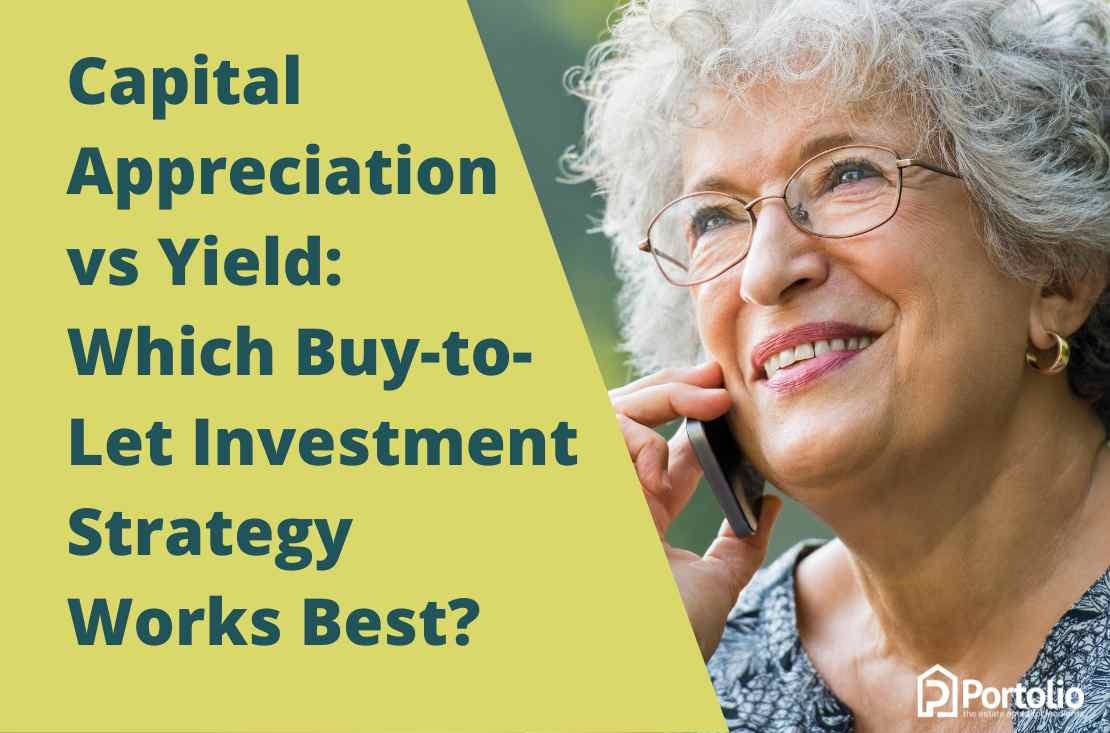Curious about capital appreciation vs yield, and which strategy might work best for you?
When considering a buy-to-let investment, the important word is ‘investment’. This isn’t a hobby done simply to while away the hours, it’s intended to generate a return which will benefit the investor.
So understanding how returns are generated, what those returns are and how to maximise them for your particular circumstances is key in deciding on your investment strategy. And, if you’re a regular reader, you’ll know we love strategy!
As a property professional, working exclusively in the buy-to-let market, I’m going to discuss capital appreciation vs yield: what they are and why they matter so that you can make better choices with regards to your investments.
Let’s define our terms
Before we go further, let’s briefly define what capital appreciation and yield are.
Capital appreciation
This is pretty straightforward – it’s the difference between the buying price and the sale price for your property. For example, if you buy at £200,000 and sell at £300,000, the capital appreciation is £100,000, or 50% of the purchase price.
This example takes no account of any taxes or expenses incurred in the process.

Yield
Yield (or rental yield) is the percentage return from annual rent on a property. The calculation is a simple percentage based on the purchase price of the investment.
For example: Purchase price £180,000. Annual rent received: £12,000. Yield will be 12,000/180,000 x 100 = 6.67%.
Landlords have some control over their yields; areas with lower than average house prices, but a healthy rental market can dramatically improve yields.
Using the above example, if the annual rent received was £18,000, the yield would now be 10%.
Which matters most?

Capital appreciation and yield both matter to all investors, however depending on their overall strategy, one might be more important than the other.
Income
If the aim of your investment is to generate regular income to replace or supplement your other sources, then yield will be a greater consideration, day to day, than capital appreciation.
Accordingly, you’ll probably be looking to invest in areas where property prices are at or below the national average but rents are reasonably strong. The North East of England is a good example of such an area, as is Aberdeen.
Here your regular return on your investment, in the form of rental income should be higher compared to regions where property prices are doing better than average.
This isn’t a cast-iron rule (when are they ever?!) as you may find properties which, while more expensive, generate an excellent rental income because they are in highly desirable locations.
Lump sum
It’s largely true that many landlords expect to benefit from both kinds of return, however there are many investors out there for whom their rental property is primarily a long-term investment.
For these investors, their property may be an adjunct to their existing pension, or it may represent all of their pension. Income, whilst welcome, is a way of covering the cost of maintaining that investment.
Their goal is to benefit from a strong property market over the longer term and to realise strong capital appreciation when they finally come to sell their property. The resulting lump sum may then be invested to provide retirement income.
Capital appreciation vs yield – the pros and cons

While both are important to the majority of property investors, there are, as you’d expect, pros and cons for each approach.
Capital appreciation
Pros
- There is the potential for a very substantial return, especially over the medium to long term.
- A long-term property investment tends to be less vulnerable to the whims of the property market as the inevitable ups and downs generally even out over time.
- It is possible to generate considerable equity in the short term depending on the state of the market
Cons
- While considerable short-term gains might happen, you may well have to commit to a long-term strategy to realise the best return on your investment.
- You’ll face increased competition from fellow investors and buyers for the best properties, therefore your initial investment may well be relatively high.
- You’ll consequently face higher costs in terms of borrowing (if relevant to you) and Stamp Duty or LLBT. You’ll also face additional dwelling supplements which, being a percentage, increase along with the purchase price.
- When you finally come to sell the property, you’ll have to pay Capital Gains Tax (CGT) on the profit you earn from the sale.

Yield
Pros
- You can affect the rental yield you earn through careful buying, so your initial outlay will most likely be lower than that involved in a capital appreciation approach.
- You’ll earn regular income from rents, possibly from day one if you buy a property with sitting tenants.
- You can use some of that income to reduce your mortgage, thereby increasing the equity in the property.
- You’ll almost certainly be looking at lower initial costs whether buying outright or buying with a mortgage. The property price will likely be lower, and as a result Stamp Duty/LLBT and any additional dwelling supplement will also be lower.
Cons
- It’s highly possible that a strategy which favours yield will result in buying properties with lower long-term prospects. Whether that’s because of the building itself, or the area it’s in, the end result will be the same.
- Income isn’t guaranteed, you will almost certainly encounter void periods where you have no tenants. Sadly your costs won’t take a similar break.
- The income you derive from rent is taxable just like any other source of income. Operating as a limited company may be advantageous, but this will depend very much on your particular circumstances.
- Capital gains tax may apply to any profit resulting from the eventual sale.
Advice from the property pros

When deciding on your property investment strategy capital appreciation vs yield is a key consideration. Your decision will depend on a host of factors, not least your personal circumstances and what you want from your investment.
In our experience, most investors look for a bit of both, albeit in different proportions. Like so much in life, in any investment, your final strategy will probably be a compromise.
If income is your chief goal, then focussing on yield is the way to go. Depending on your level of investment and personal circumstances you may decide that pursuing this goal through a limited company makes greater sense.
If capital appreciation matters more to you, expect to be competing for ‘better’ properties with expectations of a slower, but more substantial return over a longer period.
This may suit you if you view your investment as a pension, rather than income to live on. In this case, such rental income as you receive may be viewed as working cash to maintain and manage your properties, any excess being a bonus.
In summary…
Thanks for reading this far! When discussing property investment, capital appreciation vs yield is a constantly recurring theme, and for good reason.
Although I appreciate that we regularly recommend seeking professional advice on many aspects of property investment, that message is even more important here. Early choices will likely influence your decisions for years to come.
For that reason, amongst many others, we are always happy to speak to anyone considering an entry into the world of property investment. With decades of experience, we’re ideally placed to discuss this and other subjects with you.
It’s often the case that there are considerations which will affect your choices that you may not have thought of, so making the time to look at all aspects of the market will pay dividends in the long term.
If you’d like to know more about capital appreciation vs yield, or any other aspects of buy-to-let investments, just give us a call and let’s have a chat.
Written by Ross MacDonald, Director of Sales & Cofounder of Portolio
Get in touch on 07388 361 564 or email to [email protected]



Comments